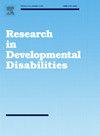Handwriting deficits in the comorbidity of dyslexia and attention-deficit/hyperactivity disorder and their electrophysiological correlates
IF 2.6
2区 医学
Q1 EDUCATION, SPECIAL
引用次数: 0
Abstract
Handwriting is a fundamental skill crucial for effective communication and learning. While previous research has demonstrated handwriting impairments in individuals with attention-deficit/hyperactivity disorder (ADHD) and developmental dyslexia (DD) separately, the impact of their comorbidity on children's handwriting abilities remains largely unexplored. This study employed a written production task and a copying task to measure handwriting speed and legibility in children with DD-only (N = 37), ADHD-only (N = 39), comorbid DD and ADHD (COM, N = 44), and typically developing children (N = 36). The findings revealed that the COM group exhibited significantly diminished handwriting speed and legibility compared to the typically developing group. Furthermore, the COM group demonstrated handwriting speed comparable to the DD-only and ADHD-only groups but reduced legibility compared to the DD-only group, suggesting both similarities and additive effects of handwriting impairments in the COM group. Finally, we examined the association between handwriting performance and intrinsic neural activity using closed-eye electrophysiological (EEG) recordings in the COM group. The results revealed that the handwriting deficit in the COM group was linked to neural activity in the frontal regions, suggesting the involvement of executive functions and/or motor execution in impaired handwriting. Collectively, this study uncovers severe handwriting impairments in individuals with comorbid DD and ADHD, underscoring the importance of assessing handwriting skills for accurate diagnosis and effective treatment of comorbid conditions.
阅读障碍和注意缺陷/多动障碍共病中的书写缺陷及其电生理相关性
书写是一项基本技能,对有效的沟通和学习至关重要。虽然之前的研究已经分别证明了患有注意力缺陷/多动障碍(ADHD)和发育性阅读障碍(DD)的个体存在书写障碍,但它们的合并症对儿童书写能力的影响在很大程度上仍未被探索。本研究采用书面生成任务和复制任务来测量单纯DD (N = 37)、单纯ADHD (N = 39)、共病DD和ADHD (COM, N = 44)和正常发育儿童(N = 36)的书写速度和易读性。研究结果显示,与正常发育组相比,COM组的书写速度和易读性明显降低。此外,COM组的书写速度与纯dd组和纯adhd组相当,但与纯dd组相比,易读性降低,这表明COM组的书写障碍既有相似性,也有附加效应。最后,我们使用闭眼电生理(EEG)记录来研究COM组的书写表现与内在神经活动之间的关系。结果显示,COM组的书写缺陷与额叶区域的神经活动有关,表明书写缺陷涉及执行功能和/或运动执行。总的来说,这项研究揭示了患有DD和ADHD合并症的个体存在严重的书写障碍,强调了评估书写技能对于准确诊断和有效治疗合并症的重要性。
本文章由计算机程序翻译,如有差异,请以英文原文为准。
求助全文
约1分钟内获得全文
求助全文
来源期刊

Research in Developmental Disabilities
Multiple-
CiteScore
5.50
自引率
6.50%
发文量
178
期刊介绍:
Research In Developmental Disabilities is aimed at publishing original research of an interdisciplinary nature that has a direct bearing on the remediation of problems associated with developmental disabilities. Manuscripts will be solicited throughout the world. Articles will be primarily empirical studies, although an occasional position paper or review will be accepted. The aim of the journal will be to publish articles on all aspects of research with the developmentally disabled, with any methodologically sound approach being acceptable.
 求助内容:
求助内容: 应助结果提醒方式:
应助结果提醒方式:


